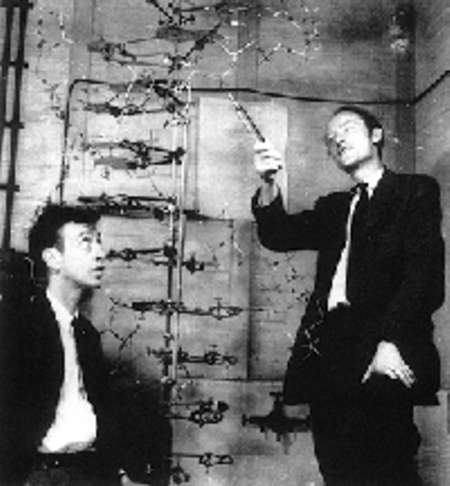
AUGUST 2004
.Francis crick,
Scientist, Dies.
A remarkably short scientific paper, known officially as a letter, was published on 25 April 1953 in Nature, by James Watson and Francis Crick.
It was perhaps the most momentous paper of the modern era, proposing a structure for the chemical, DNA (Deoxyribose Nucleic Acid), which composes the hereditary material of all living cellular organisms.
The proposed structure -
a double helix - rapidly became an icon, aesthetically
beautiful, and stunning in its capacity to explain how
DNA is replicated in order to transmit the genetic
material to the next generation.
Unassuming words
It is now one of the most famous scientific papers of all time, but began with an unassuming pair of sentences: "We wish to suggest a structure for the salt of deoxyribose nucleic acid (DNA). This structure has novel features which are of considerable biological interest."
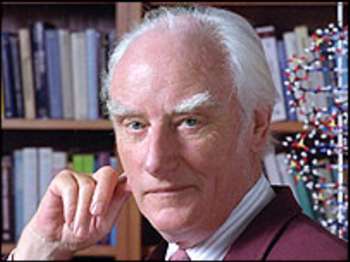
Francis Crick, who helped discover the double helix shape of DNA along with James Watson, has died aged 88.
Professor Crick died at Thornton Hospital in San Diego, USA.
The British-born scientist won the Nobel Prize for his work on DNA's structure, which he helped model in 1953 at the University of Cambridge.
"I will always
remember Francis for his extraordinarily focused
intelligence," Professor Watson said on
Thursday.
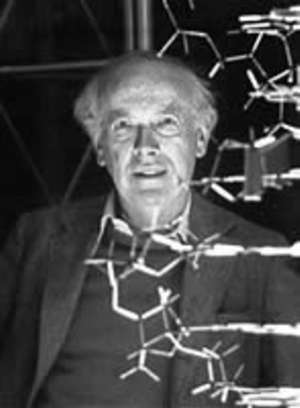
"He treated me as though I were a member of his family. Being with him for two years in a small room in Cambridge was truly a privilege," he continued.
"I always looked forward to being with him and speaking to him, up until the moment of his death. He will be sorely missed."
Nobel prize
Professor Crick was made a Fellow of the Royal Society in 1959, three years before he was awarded a Nobel prize. Primarily this was for his work on DNA, but also for his study of the structure of proteins and viruses.
In late 1939, when Rosalind was a nineteen-year-old
student at Newnham College, Cambridge, 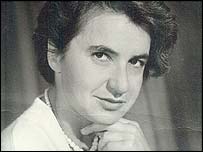 studying chemistry, she made a
speculative sketch in her workbook of a form of
nucleic acid. studying chemistry, she made a
speculative sketch in her workbook of a form of
nucleic acid. Rosalind's biographer Brenda Maddox writes in 'The Dark Lady of DNA' that the form "represents a helical structure. She made a note to herself: 'Geometrical basis for inheritance?'" |
Research undertaken by Maurice Wilkins and Rosalind Franklin paved the way for Francis Crick and James Watson's famous discovery.
Wilkins and Franklin took the first X-ray images of DNA in 1950, which caught the attention of Crick and Watson - inspiring them to investigate further.
Professor's Crick's death comes one year after the 50th anniversary of the discovery of the structure of DNA.
"Just last
year we were celebrating the 50th anniversary of the
publication in the journal 'Nature' of his landmark
scientific paper, written with James Watson, which
described the correct double helix structure of DNA for
the first time," said Lord May.
* * * * *
Professor Crick was born in Northampton in the UK but had been living in La Jolla, California, US. He was a distinguished research professor and former president of the Salk Institute in San Diego.
"Francis Crick will be remembered as one of the most brilliant and influential scientists of all time," said Richard Murphy, the Salk Institute's president and chief executive officer.
Dr Matt Ridley, author of Genome and Nature Vs Nurture said: "Francis Crick made not one but many great scientific discoveries.
"He found that genes are digital codes written on DNA molecules, he found that the code is written in three-letter words and he was instrumental in cracking the code.
"Any one of
those things would have got him into the scientific
pantheon. Discovering all three places him alongside
Newton, Darwin and Einstein."
THE PAPER
Watson and Crick's paper was published without their undertaking a single experiment.
Instead, the experiments underpinning their albeit inspired models were undertaken over the previous three years in the Strand basement laboratories of the Medical Research Council Biophysics Unit at King's.
 The prime movers in obtaining the data at King's
were Professor Maurice Wilkins, who had commenced pilot
studies on the use of X-rays to analyse DNA structure,
and Dr Rosalind Franklin, a Fellow who arrived at King's
in January 1951, and who advanced the X-ray resolution of
DNA structure to a new level of clarity and
sophistication.
The prime movers in obtaining the data at King's
were Professor Maurice Wilkins, who had commenced pilot
studies on the use of X-rays to analyse DNA structure,
and Dr Rosalind Franklin, a Fellow who arrived at King's
in January 1951, and who advanced the X-ray resolution of
DNA structure to a new level of clarity and
sophistication.
Their data were published alongside the
Watson and Crick paper but because neither provided a
compelling model for DNA structure, they have often been
overlooked.
The insight the discovery provided: how human characteristics arise from our individual genes and created a veritable super-highway of research, ushering in gene therapy for inherited diseases and culminating in the recent sequencing of the human genome.
Almost as an incidental, the discovery
paved the way for a whole new arena of human endeavour,
the biotechnology industry.
Key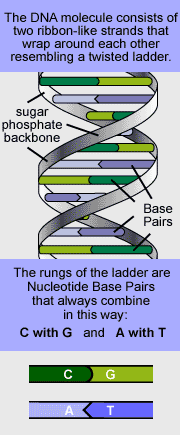
![]()
![]() Adenine, Thymine base pair
Adenine, Thymine base pair
![]()
![]() Guanine, Cytosine base pair
Guanine, Cytosine base pair
![]()
![]() Helical backbone
Helical backbone
'The key to life'
DNA's double helix holds the key to life. The secret
discovered by Watson and Crick in 1953 is that there are
four possible types of rung on the ladder formed by the
double helix.
There are A-T rungs, where adenine bonds to thymine, T-A rungs where thymine bonds to adenine, C-G rungs where cytosine bonds to guanine, and G-C rungs where guanine bonds to cytosine. No other combinations are possible due to the shape of the four substances.
The outer helices of the DNA molecule, coloured blue on our model, are made up of a chain of circular sugar molecules, each bearing a phospate group. Biochemists call the helices "the sugar-phosphate backbone".
There are about 2.85 billion rungs on the ladder of human DNA. The initial letters of the rungs spell out the sequence of the human genome, the blueprint for each generation of new life.
DNA and Human Diversity
Although we all look quite different from one another, we are surprisingly alike at the DNA level. The DNA of most people is 99.9 percent the same.
Only about 3 million base pairs are responsible for the differences among us — which is only one tenth of 1% of our DNA. Yet these DNA base sequence variations influence most of our physical differences and many of our other characteristics, as well.
